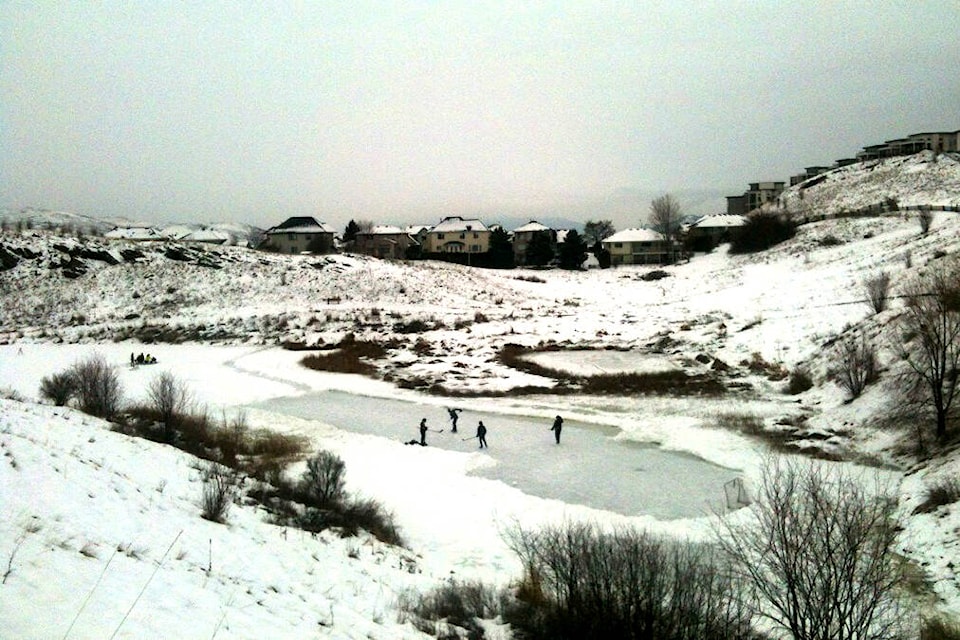Roseanne Van Ee
Okanagan91������Ƶ�s Nature Nut
Our lakes dramatically change from summer91������Ƶ�s warm recreational reservoirs to cold and sometimes frozen winter expanses. But, how often do we stop to ponder the lakes91������Ƶ� seasons?
I remember a winter when the temperature dropped so low in November that the bays at the south end of Kalamalka Lake froze. Bitter winds swept off the snow leaving it as clear as glass. Skating on the ice was eerie; weeds, bubbles and even some fish were suspended in the glassy lake surface. It was fascinating! I wondered what was happening below that winter?
Water temperatures don91������Ƶ�t fluctuate as rapidly as the air above. Water91������Ƶ�s chemistry is interesting and creates fascinating change. Water molecules contract and become denser (tightly packed) as temperatures lower, but at four degree Celsius something unusual happens; water molecules start binding together, expand and become lighter, solid ice by zero C. Freezing ice can expand up to nine per cent. That91������Ƶ�s why ice floats on the denser liquid water molecules.
Our smaller to mid-size valley and mountain lakes such as Swan, Otter, Wood and Duck lakes have interesting seasonal water cycles causing temperature layering and 91������Ƶ�turn overs91������Ƶ� of oxygen and nutrients. Once the ice thaws from these lakes, the water temperature is an even 4C. Winds whip the surface water pushing and stirring oxygen rich surface water to the lake91������Ƶ�s bottom. This circulating current then rises plankton and other nutrients up to the top.
In summer, the upper water layer is warmed by the sun. It becomes less dense, floats and doesn91������Ƶ�t mix with the lower, colder water. The temperature differences increase causing less mixing of the water. The warm, well-oxygenated surface is a paradise rich in life. This is where the summer action is 91������Ƶ� the algae blooms, the zooplankton (microscopic animals that feed on phytoplankton) graze and the insects and fish feed.
The lakes colder bottom gets depleted of oxygen from decomposition of the lake life91������Ƶ�s wastes and by oxygen consumption from the lake91������Ƶ�s deep water organisms 91������Ƶ� mostly bottom feeding scavengers. Autumn91������Ƶ�s colder nights cool the surface again bringing the water to a uniform 4C and the breezes result in recirculation or 91������Ƶ�turn-over91������Ƶ� redistributing oxygen throughout. This is critical as winter91������Ƶ�s ice surface cuts off the air/oxygen exchange and reduces oxygen-producing photosynthesis by aquatic plants. Animals such as fish and hibernating frogs, toads and turtles wintering beneath the ice have to survive on the depleted oxygen.
Our large valley lakes however, like Okanagan and Kalamalka, have massive, well-oxygenated deep water zones and enough water mass to maintain warm rising water through our moderate winters to prevent total freeze over. In past years though, during long cold spells, certain shallow bays freeze up. Stories are recounted of Kelowna and Vernon bays freezing paddlewheelers in solid.
It takes many years for our large lakes to turn over their nutrients. Loons and grebes leave their small lake summer homes to winter on our larger lakes as they need open waters to feed and take flight. Watch for them on beachfront winter walks. Enjoy the season!
Roseanne Van Ee enthusiastically shares her knowledge of the outdoors to help readers experience and enjoy nature. Follow her on Facebook.
READ MORE: Scoop on squirrels: Okanagan91������Ƶ�s Nature Nut
READ MORE:



